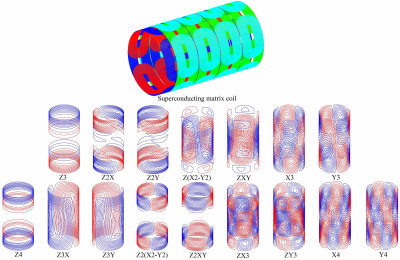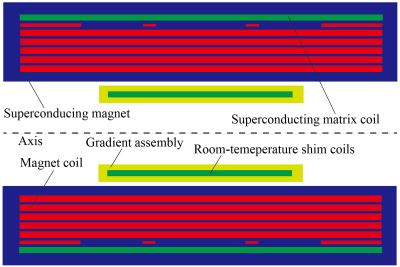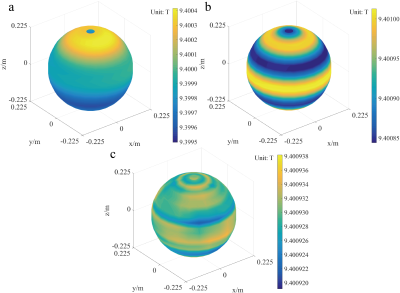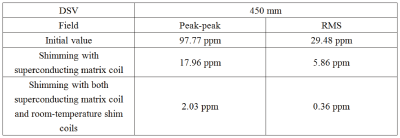3334
A new route of ultrahigh field MRI shimming: hybrid superconducting matrix coil and multi-order spherical harmonics room-temperature shim coils
Yaohui Wang1,2, Qiuliang Wang1,2, Yang Liu1, Jigang Zhao1, Hui Wang1, Junsheng Cheng1, and Feng Liu3
1Institute of Electrical Engineering, Chinese Academy of Sciences, Beijing, China, 2University of Chinese Academy of Sciences, Beijing, China, 3School of Information Technology and Electrical Engineering, The University of Queensland, Brisbane, Australia
1Institute of Electrical Engineering, Chinese Academy of Sciences, Beijing, China, 2University of Chinese Academy of Sciences, Beijing, China, 3School of Information Technology and Electrical Engineering, The University of Queensland, Brisbane, Australia
Synopsis
A new route for ultrahigh field MRI shimming was proposed which utilized hybrid superconducting matrix coil and multi-order room-temperature shim coils. The proposed scheme was aimed to create a stable and accurate shimming solution for high homogeneous magnetic field magnet. A real 9.4T whole-body MRI magnetic field profile was used to validate the shimming strategy and a remarkable effect was achieved. Therefore, the new shimming method deserves to generalize to ultrahigh field MRI system.
Introduction
The current magnet shimming strategies in MRI can be mainly divided into two categories, namely field-based method or harmonics-based method. Passive shimming is a commonly-used field-based method, which utilizes several shim trays with independent iron pockets [1, 2]. The quantity of the iron piece in an individual pocket is an optimizable parameter to elevate the field homogeneity. There are also some reports using coils or loop matrix inserted in the MRI magnet bore, which increase the field homogeneity by adjusting the current of each coil element [3, 4]. On the other hand, room-temperature shim coils [5, 6] are typically employed to implement the harmonics-based shimming. A single shim coil generates a magnetic field profile corresponding to the harmonic decomposition, and it is controlled independently to offset certain amount of harmonic components of the overall magnetic field. Compared with the coil shimming technique, the passive shimming can be economical. However, its thermal instability issue caused by gradient coils is unpredictable, which is possible to deteriorate the field quality when the scanner is under operation. A replacement of shim tray by superconducting matrix shim coil residing in the magnet system can seek a constant environment for the shim device. Meanwhile, the spare space originally for shim tray can be used to add more shim coils and cooling pipes. A more powerful shimming framework by combing a superconducting matrix coil and multi-order room-temperature shim coils is proposed for ultrahigh field MRI in this work.Method
The superconducting matrix coil is composed of several saddle coils with a matrix arrangement 8-row × 8-column. The target function for the shimming optimization is to minimize the magnetic field deviation over the imaging region. For the safety of the superconducting matrix coil and the thermal load control of current lead, the maximum current in a single matrix coil element is constrained. Eq. (1) and (2) express the optimization function,$$\min:\sum_{s=1}^S(Bz_s+{\bf{AI}}-x)^2\qquad\qquad(1)$$$$-I_{max}<I_k<I_{max}\qquad\qquad(2)$$where Bzs is the bare magnetic field of the magnet system, A is the transfer matrix of the superconducting matrix coil, I is the current vector, x is the mean value of the shimmed magnetic field, Imax is the maximum allowable current, which is constrained within 5 A and k is the port number of the matrix coil.Since the superconducting matrix coil is located in the magnet system, the gap of the primary and shielding coils in the gradient assembly can be used to arrange more shim coils. Fig. 1 shows the coil pattern of the superconducting matrix coil and a set of third and fourth order room-temperature shim coils. The fifth and sixth order zonal shim coils are also included for a full offset of the zonal harmonic components.
For validation, the proposed novel hybrid strategy was tested for the shimming of magnetic field of a 9.4T whole-body superconducting magnet fabricated by IEE CAS is used for the validation of [7]. The illustration of the locations of the superconducting matrix coil and room-temperature shim coils were shown in Fig. 2.
Results
Fig. 3 compares the magnetic field distribution among bare field, shimming with superconducting matrix coil and additional shimming with room-temperature shim coils. Table I lists the field homogeneity evaluation over the imaging volume.The initial magnetic field homogeneity over the 450-mm imaging volume (sphere) is 97.77 ppm with peak-peak value and 29.48 ppm (RMS). With optimized currents in the matrix coil element, the peak-peak homogeneity increased to 17.96 ppm and RMS homogeneity increased to 5.86 ppm. Subsequently, room-temperature shim coils is responsible to cancel the remaining harmonic components, reaching a final homogeneity with peak-peak value only 2.03 ppm and RMS value only 0.36 ppm.
Discussions
To achieve an adequate field-adjustment capability of the superconducting matrix coil, the coil element was selected with a large arc side and the matrix coil elements were divided into four layers (as shown in Fig. 1) to avoid overlapping. In our next work, the layout of the matrix elements will be optimized to achieve a better solution.Conclusion
In this work, we proposed a new shimming technique that combines superconducting matrix shim coil and multiple-order room-temperature shim coils. The proposed technique was tested in the case of shimming a 9.4T whole-body MRI magnet, and it showed that the hybrid shimming technique was capable of handling larger inhomogeneous magnetic field profile with higher-order spherical harmonics.Acknowledgements
This work is funded by National Key Research and Development Project (No. 2020YFF01014702, No. 2019YFC0117604), Beijing Science and Technology Plan (No. Z181100003818020) and International Partnership Program of Chinese Academy of Sciences (No. 182111KYB20170067, No. 182111KYSB20170039).References
[1] A. Belov, V. Bushuev, M. Emelianov, V. Eregin, Y. Severgin, S. Sytchevski, et al., "Passive shimming of the superconducting magnet for MRI," IEEE Transactions on Applied Superconductivity, vol. 5, pp. 679-681, 1995. [2] X. Kong, M. Zhu, L. Xia, Q. Wang, Y. Li, X. Zhu, et al., "Passive shimming of a superconducting magnet using the L1-norm regularized least square algorithm," Journal of Magnetic Resonance, vol. 263, pp. 122-125, 2016. [3] C. Juchem, T. W. Nixon, S. McIntyre, V. O. Boer, D. L. Rothman, and R. A. de Graaf, "Dynamic multi-coil shimming of the human brain at 7T," Journal of Magnetic Resonance, vol. 212, pp. 280-288, 2011. [4] S. Littin, F. Jia, K. J. Layton, S. Kroboth, H. Yu, J. Hennig, et al., "Development and implementation of an 84-channel matrix gradient coil," Magnetic Resonance in Medicine, vol. 79, pp. 1181-1191, 2018. [5] P. Hudson, S. D. Hudson, W. B. Handler, and B. A. Chronik, "Finite-length shim coil design using a fourier series minimum inductance and minimum power algorithm," Concepts in Magnetic Resonance Part B: Magnetic Resonance Engineering, vol. 37B, pp. 245-253, 2010/10/01 2010. [6] S. Clare, J. Evans, and P. Jezzard, "Requirements for room temperature shimming of the human brain," Magnetic Resonance in Medicine, vol. 55, pp. 210-214, 2006. [7] Q. Wang, Y. Dai, B. Zhao, S. Song, C. Wang, L. Li, et al., "A Superconducting Magnet System for Whole-Body Metabolism Imaging," IEEE Transactions on Applied Superconductivity, vol. 22, pp. 4400905-4400905, 2012.Figures

Fig. 1 Superconducting
matrix coil and the third and fourth order room-temperature shim coils

Fig. 2
Illustration of the locations of the superconducting matrix coil and
room-temperature shim coils (a cross section view)

Fig. 3 Magnetic field
distribution in the imaging volume: (a) initial magnetic field profile, (b) shimming
with superconducting matrix coil and (c) further shimming with room-temperature
shim coils

Table I Homogeneity evaluation
over the imaging volume